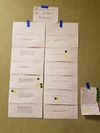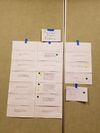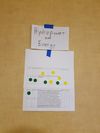Difference between revisions of "FY18-20 GCMRC Triennial Budget and Workplan"
Cellsworth (Talk | contribs) |
Cellsworth (Talk | contribs) |
||
| Line 71: | Line 71: | ||
*[http://gcdamp.com/index.php?title=ECOSYSTEM Natural Processes]: Not used (is an evaluation of above resources as related to “natural” benchmarks) | *[http://gcdamp.com/index.php?title=ECOSYSTEM Natural Processes]: Not used (is an evaluation of above resources as related to “natural” benchmarks) | ||
| − | | | + | |- |
| + | ! <h2 style="margin:0; background:#cedff2; font-size:120%; font-weight:bold; border:1px solid #a3b0bf; text-align:left; color:#000; padding:0.2em 0.4em;"> LTEMP BiOp Triggers for [http://gcdamp.com/index.php?title=Humpback_Chub_Page Humpback Chub] (2016) </h2> | ||
| + | |- | ||
| + | |style="color:#000;"| | ||
| + | If the '''Tier 1''' (point abundance estimate for adult chub in the Colorado River mainstem aggregation and Little Colorado River fall below 9,000 as estimated by the currently accepted population model OR if recruitment of sub-adult chub [150-199 mm] does not equal or exceed estimated adult mortality as described in document) and '''Tier 2''' triggers (point abundance estimate of adult chub decline to <7,000 fish, as estimated by the currently accepted humpback chub population model) are met and the prescribed conservation measures and remedial actions under each trigger do not mitigate a decline in the humpback chub population, then incidental take will have been exceeded. | ||
| + | |||
| + | Tier 1 would emphasize conservation actions (i.e., expansion of translocation actions in the Little Colorado River, head-starting larval chub to later translocate) that would take place early during an adult or sub-adult humpback chub population decline (should that happen). Tier 2 would serve as a backstop prescribing mechanical nonnative predator removal (threat reduction) if conservation measures did not mitigate a decline in chub abundance. | ||
| + | |||
| + | |- | ||
| + | ! <h2 style="margin:0; background:#cedff2; font-size:120%; font-weight:bold; border:1px solid #a3b0bf; text-align:left; color:#000; padding:0.2em 0.4em;"> LTEMP BiOp Conservation Measures [http://gcdamp.com/index.php?title=Long-term_Experimental_and_Management_Plan_(LTEMP)] (2016) </h2> | ||
| + | |- | ||
| + | |style="color:#000;"| | ||
| + | |||
| + | == [http://gcdamp.com/index.php?title=Humpback_Chub_Page Humpback Chub] == | ||
| + | |||
| + | Ongoing actions: | ||
| + | |||
| + | *Translocations of humpback chub into tributaries of the Colorado River in Marble and Grand Canyons | ||
| + | *Spring and fall humpback chub population estimate | ||
| + | *Control or removal of nonnative fish in tributaries prior to chub translocations | ||
| + | *Humpback chub refuge population at a federal hatchery | ||
| + | *Ensure that a stable or upward trend of humpback chub mainstem aggregations can be achieved by: | ||
| + | #Annual monitoring of the Little Colorado River humpback chub aggregation (e.g., juvenile chub monitoring parameters). | ||
| + | #Annual monitoring in the mainstem Colorado River to determine status and trends of humpback chub. | ||
| + | #Periodic surveys to identify additional aggregations and individual humpback chub. | ||
| + | #Evaluate existing aggregations and determining drivers of these aggregations. | ||
| + | #Explore means of expanding humpback chub populations outside of the Little Colorado River Inflow aggregation. | ||
| + | *Disease and parasite monitoring | ||
| + | |||
| + | New actions: | ||
| + | |||
| + | *Feasibility study for translocation of humpback chub into Upper Havasu Creek (above Beaver Falls). | ||
| + | *Evaluate other tributaries for potential translocations. | ||
| + | |||
| + | == [http://gcdamp.com/index.php?title=GCDAMP_RAZU_Fish Razorback Sucker] == | ||
| + | |||
| + | Ongoing actions: | ||
| + | |||
| + | *Larval and small-bodied fish monitoring. | ||
| + | |||
| + | == Actions to benefit all [http://gcdamp.com/index.php?title=FISH native aquatic species] == | ||
| + | |||
| + | Ongoing actions: | ||
| + | |||
| + | *Investigate the possibility of renovating Bright Angel and Shinumo Creeks with a chemical piscicide. | ||
| + | *Remove [http://gcdamp.com/index.php?title=Brown_Trout brown trout] (and other [http://gcdamp.com/index.php?title=Nonnative_Invasive_Aquatic_Species nonnative species]) from Bright Angel Creek and the Bright Angel Creek Inflow reach of the Colorado River, and from other areas where new or expanded spawning populations develop. | ||
| + | |||
| + | New actions: | ||
| + | |||
| + | *Explore the efficacy of a [http://gcdamp.com/index.php?title=TEMPERATURE temperature control device] at the dam to respond to potential extremes in hydrological conditions due to climate conditions that could result in [http://gcdamp.com/index.php?title=Nonnative_Invasive_Aquatic_Species nonnative fish] establishment. | ||
| + | *Preventing the passage of deleterious invasive nonnative fish through Glen Canyon Dam. | ||
| + | *Fund the NPS and GCMRC on the completion of planning and compliance to alter the [http://gcdamp.com/index.php?title=Green_Sunfish_Page backwater slough at River Mile (RM) 12]. | ||
| + | *Develop a plan for implementing rapid response control efforts for newly establishing or existing deleterious invasive nonnative species. | ||
| + | *Experimental use of [http://gcdamp.com/index.php?title=Trout_Management_Flows TMFs] to inhibit [http://gcdamp.com/index.php?title=Brown_Trout brown trout] spawning and recruitment in Glen Canyon | ||
| + | |||
| + | == Southwestern willow flycatcher and Yuma Ridgway’s rail == | ||
| + | |||
| + | *Conduct Yuma Ridgway’s rail surveys | ||
| + | *Conduct southwestern willow flycatcher surveys | ||
| + | |||
| + | |- | ||
| + | ! <h2 style="margin:0; background:#cedff2; font-size:120%; font-weight:bold; border:1px solid #a3b0bf; text-align:left; color:#000; padding:0.2em 0.4em;"> LTEMP Experimental Actions [http://gcdamp.com/index.php?title=Long-term_Experimental_and_Management_Plan_(LTEMP)] </h2> | ||
| + | |- | ||
| + | |style="color:#000;"| | ||
| + | |||
| + | *[http://gcdamp.com/index.php?title=The_HFE_Page Spring and fall HFEs] including proactive spring HFEs and extended duration fall HFEs. | ||
| + | *[http://gcdamp.com/index.php?title=Nonnative_Invasive_Aquatic_Species Mechanical removal of nonnative species] | ||
| + | *[http://gcdamp.com/index.php?title=Trout_Management_Flows Experimental Trout Management Flows (TMFs)] | ||
| + | *[http://gcdamp.com/index.php?title=The_2000_Low_Summer_Steady_Flow_Experiment Low summer flows] | ||
| + | *[http://gcdamp.com/index.php?title=The_Bugflow_Experiment Low steady weekend flows (“bug flows”)] | ||
| + | *[http://gcdamp.com/index.php?title=Riparian_Vegetation Experimental riparian vegetation treatment activities] | ||
| + | |||
| + | |} | ||
<!-- | <!-- | ||
Revision as of 11:41, 1 March 2017
|
|
GCMRC Triennial Budget and Work Plan -- Fiscal Years 2018-2020 |
| Long-term Experimental and Management Plan (LTEMP) The LTEMP provides the basis for decisions that identify management actions and experimental options that will provide a framework for adaptively managing Glen Canyon Dam operations over the next 20 years |
LTEMP Science Plan The LTEMP Science Plan describe a strategy by which monitoring and research data in the natural and social sciences will be collected, analyzed, and provided to DOI, its bureaus, and to the GCDAMP in support of implementation of LTEMP. |
Core Monitoring Plan The GCMRC Core Monitoring Plan (CMP) describes the consistent, long-term, repeated measurements using scientifically accepted protocols to measure status and trends of key resources to answer specific questions. Core monitoring is implemented on a fixed schedule regardless of budget or other circumstances (for example, water year, experimental flows, temperature control, stocking strategy, nonnative control, etc.) affecting target resources. |
Monitoring and Research Plan The GCMRC Monitoring and Research Plan (MRP) specifies (1) core monitoring activities, (2) research and development activities, and (3) long-term experimental activities consistent with the strategies and priorities established in this SSP to be conducted over the next 5 years to address some of the strategic science questions associated with AMWG priority questions. |
Budget and Workplan The GCMRC Triennial Work Plan (TWP) identifies the scope, objectives, and budget for monitoring and research activities planned for a 3-year period. When completed, the triennial work plan will be consistent with the MRP. |
|---|
|
|














